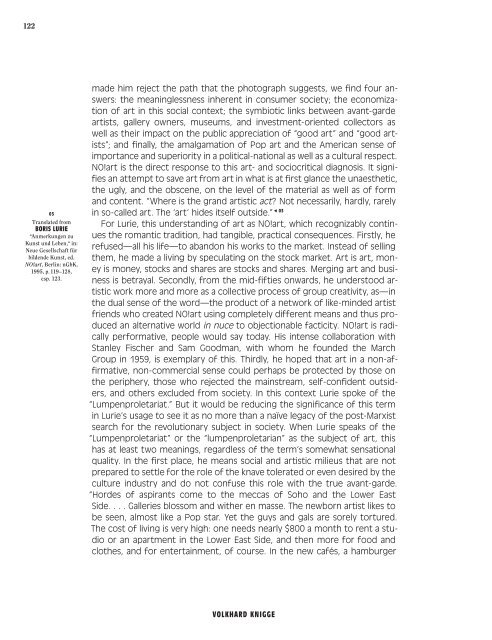The Art of
1WQggTh
1WQggTh
Create successful ePaper yourself
Turn your PDF publications into a flip-book with our unique Google optimized e-Paper software.
122<br />
03<br />
Translated from<br />
BORIS LURIE<br />
“Anmerkungen zu<br />
Kunst und Leben,“ in:<br />
Neue Gesellschaft für<br />
bildende Kunst, ed.<br />
NO!art, Berlin: nGbK,<br />
1995, p. 119–128,<br />
esp. 123.<br />
made him reject the path that the photograph suggests, we find four answers:<br />
the meaninglessness inherent in consumer society; the economization<br />
<strong>of</strong> art in this social context; the symbiotic links between avant-garde<br />
artists, gallery owners, museums, and investment-oriented collectors as<br />
well as their impact on the public appreciation <strong>of</strong> “good art” and “good artists”;<br />
and finally, the amalgamation <strong>of</strong> Pop art and the American sense <strong>of</strong><br />
importance and superiority in a political-national as well as a cultural respect.<br />
NO!art is the direct response to this art- and sociocritical diagnosis. It signifies<br />
an attempt to save art from art in what is at first glance the unaesthetic,<br />
the ugly, and the obscene, on the level <strong>of</strong> the material as well as <strong>of</strong> form<br />
and content. “Where is the grand artistic act? Not necessarily, hardly, rarely<br />
in so-called art. <strong>The</strong> ‘art’ hides itself outside.” 03<br />
For Lurie, this understanding <strong>of</strong> art as NO!art, which recognizably continues<br />
the romantic tradition, had tangible, practical consequences. Firstly, he<br />
refused—all his life—to abandon his works to the market. Instead <strong>of</strong> selling<br />
them, he made a living by speculating on the stock market. <strong>Art</strong> is art, money<br />
is money, stocks and shares are stocks and shares. Merging art and business<br />
is betrayal. Secondly, from the mid-fifties onwards, he understood artistic<br />
work more and more as a collective process <strong>of</strong> group creativity, as—in<br />
the dual sense <strong>of</strong> the word—the product <strong>of</strong> a network <strong>of</strong> like-minded artist<br />
friends who created NO!art using completely different means and thus produced<br />
an alternative world in nuce to objectionable facticity. NO!art is radically<br />
performative, people would say today. His intense collaboration with<br />
Stanley Fischer and Sam Goodman, with whom he founded the March<br />
Group in 1959, is exemplary <strong>of</strong> this. Thirdly, he hoped that art in a non-affirmative,<br />
non-commercial sense could perhaps be protected by those on<br />
the periphery, those who rejected the mainstream, self-confident outsiders,<br />
and others excluded from society. In this context Lurie spoke <strong>of</strong> the<br />
“Lumpenproletariat.” But it would be reducing the significance <strong>of</strong> this term<br />
in Lurie’s usage to see it as no more than a naïve legacy <strong>of</strong> the post-Marxist<br />
search for the revolutionary subject in society. When Lurie speaks <strong>of</strong> the<br />
“Lumpenproletariat” or the “lumpenproletarian” as the subject <strong>of</strong> art, this<br />
has at least two meanings, regardless <strong>of</strong> the term’s somewhat sensational<br />
quality. In the first place, he means social and artistic milieus that are not<br />
prepared to settle for the role <strong>of</strong> the knave tolerated or even desired by the<br />
culture industry and do not confuse this role with the true avant-garde.<br />
“Hordes <strong>of</strong> aspirants come to the meccas <strong>of</strong> Soho and the Lower East<br />
Side. . . . Galleries blossom and wither en masse. <strong>The</strong> newborn artist likes to<br />
be seen, almost like a Pop star. Yet the guys and gals are sorely tortured.<br />
<strong>The</strong> cost <strong>of</strong> living is very high: one needs nearly $800 a month to rent a studio<br />
or an apartment in the Lower East Side, and then more for food and<br />
clothes, and for entertainment, <strong>of</strong> course. In the new cafés, a hamburger<br />
VOLKHARD KNIGGE


